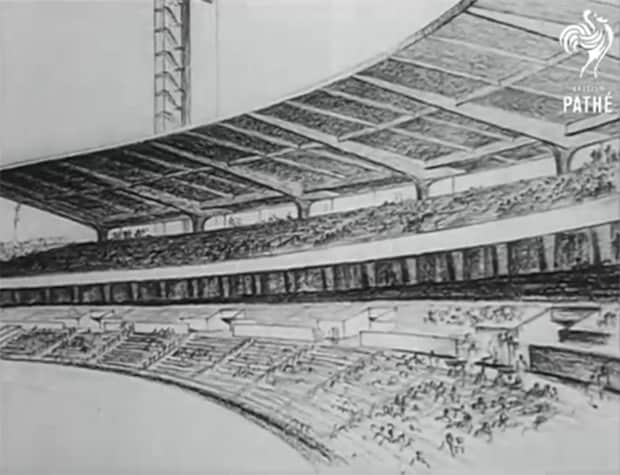On the evening of Wednesday, February 4, 1953, about 500 members gathered at the Carlton Recreation Ground (now Ikon Park) for the 88th Annual Meeting of the Carlton Football Club.
Carlton President KG Luke was there, although his health was cause for some concern given he had only just undergone serious surgery.
How heavy of heart the great “KG” must have been, with news having filtered through that the Games of the XVI Olympiad, previously earmarked for a redeveloped 100,000+-seat Carlton venue, had been switched to the MCG.
It was, after all, KG Luke who audaciously secured the 1956 Games for his beloved Princes Park – only to be thwarted by the Melbourne Cricket Club through the intervention of the then Premier John Cain senior.
Luke offered the floor to Carlton Vice-President Mr. W. Townsend, who read from an extensive statement attached to the minutes of this meeting. In response, Luke declared that “he regretted that the work was not to proceed at Carlton because he hoped this would become the people’s ground”.

Ern Henfry, Dr. Philip B. McCumisky and President Kenneth Luke, 1950. (Photo: Carlton Media)
According to the minutes: “He (Luke) was disappointed that the Games had been lost to Carlton; the methods used were all foreign to his manner of doing things. He was sure that it was not only finance that was the obstacle because he knew the £300,000 could be raised from outside sources and one of our own district residents had offered £10,000 as a loan”.
The following is Townsend’s address to Members in respect of the loss of the 1956 Olympics to Carlton. The never-before-published address has been found within the faded yellowing pages of club minutes of the 1953 year - and in it, the then Premier of Victoria John Cain senior comes in for stinging criticism.
REPORT FOR CARLTON MEMBERS
The recent cancellation of the selection of the Carlton Ground as the site for the athletic stadium for the Olympics of 1956 and the transfer of the site to the Melbourne Cricket Ground is an official decision, and however much it may be open to criticism it is the job of all Melbourne citizens including the Carlton supporters to do what they can to ensure success of the altered scheme. Our congratulations and good wishes go to the Melbourne authorities.
However, Carlton members are entitled to know the relevant matters and the following salient facts are therefore presented:
1. The Carlton Ground was not seriously considered for the site until (1) the Showgrounds which was the original selection was decided to be unsuitable and (2) the Melbourne Cricket Ground was for the second time refused as the site, on the ground apart from other aspects that the conversion of the arena was engineeringly impracticable.
2. When the Carlton Ground did come to be considered, it was assumed by the Carlton authorities that considerable financial responsibility would naturally have to be undertaken, probably with the assistance from Governments and Council by way of subsidy or loan.
3. When Carlton was officially selected as the site, a conference between representatives of the Federal and State Governments and the Melbourne City Council decided to bear the whole financial burden between such authorities. This had been neither sought nor expected by Carlton but was naturally appreciated and rendered unnecessary any further consideration of the Ground authorities in provision of capital finance. The selection of the site and the decision of the Conference received enthusiastic approbation from all sections of the community.
4. The Carlton Ground was handed over completely to the Olympic Organizing committee, the clubs voluntarily agreeing to vacate the Ground perhaps for some seasons. Full control in all respects for construction and otherwise was given to the Olympic Committee.
5. The architectural competition was held in accordance with Olympic traditions, and Mr. Coles and Mr. Luke as Chairman and Deputy Chairman of the Control Committee went overseas entirely at their own expense in order to observe the conditions as to stadium and administration and housing at Helsinki and in addition inspected through America all the major sporting stadiums in order to have a complete picture of the best features of modern sporting stadiums. Their ideas and observations as brought back have been superimposed on the Carlton plans and are of course included in the estimated total capital cost. This includes such essential matters as press and radio accommodation and facilities which are of an extraordinary extent and complication. Months of very active work has been done by the Architect with a considerable staff of expert assistants.
6. Mr. Cain early in January stated that the Carlton site was too expensive and at a Conference convened by him of representatives of the Federal and State Governments, Melbourne city Council and Olympic authorities and held on Monday 26th January he stated that he would not go beyond the state’s original estimated proportion of the cost namely £312,000, also that he would not provide the amount required for providing housing for the athletes, estimated at £2,000,000.

The proposed stadium redesign, 1952. (Photo: Supplied)
7. Mr. Coles and the Architect gave consideration to revision of the Carlton plans in order to eliminate some of the roofing and some of the architectural features which while of value from the point of view of the architectural competition had no relation to the actual public accommodation. Still leaving the seating capacity at 80,000 the cost of the revised scheme amounted to £858,000. This was based on detailed plans and careful computation, the figure being guaranteed within 5% by Melbourne’s foremost Builder, the Architect, the Structural Engineer and the Quantity Surveyor. Despite the suddenness of the matter and the limited time available, guarantees were able to be offered on behalf of Carlton for the provision of £300,000 from outside sources towards such cost, which would have left the governments and Council with only £558,000 to be provided towards the stadium, of which the one-quarter proportion of the State would have been less than £140,000.
8. At the adjourned Conference held on Monday 2nd February, all interested parties except Mr. Cain supported the Carlton project. However in order to force the issue Mr. Cain said notwithstanding his previous statement that his limit was £312,000 not one penny would be provided if the Games were at Carlton. Sooner than run the risk of losing the Games, all other parties then agreed to the Melbourne Cricket Ground being the site. Mr. Cain having achieved his object then assured Mr. Coles that the money would be made available for housing.
9. Representatives of the Melbourne Cricket Club were present at the Conference on 2nd February and not only were present at the discussions but even participated in the drafting of motions and other matters before the Meeting. The Carlton Ground Committee was not represented nor invited either to be present at the Meeting or to confer or to submit any representatives beforehand.
10. Since Mr. Cain made his first announcement as to intention to change the site, no communication whatsoever has been received by the Carlton Ground Committee. Such Committee has not received any intimation that the site was to be reconsidered nor any invitation to confer or to submit any representations or views as to figures or otherwise. In short the Committee has been treated with insolent discourtesy entirely inconsistent with the high office of the Premier.

Former Carlton president Sir Kenneth Luke. (Photo: Supplied)
11. Insofar as the only criticism and ground of the change of the original firm decision that the site was to be at Carlton was on the question of finance, the following comparisons should be made: (a) Cost of revised stadium at Carlton £858,000, of which £300,000 was available as stated above. (b) Cost of stadium at Melbourne – 1 Building extensions £300,000. 2 Arena £300,000. 3 25% discount to members on admission fees £200,000. 4 Architects fees rendered useless by abandonment £40,000 – (total) £840,000. Items 1 and 2 are not based on any plans as no details plans have been prepared or are available. It will be surprising if these figures are not greatly exceeded. The discount to members on admission fees is a conservative figure being computed only to 25,000 admissions and based on medium prices for seats at the rate applicable at Helsinki. It is to be noted that within a day or so of the location of the site to Melbourne the Melbourne authorities have already officially announced intention to increase membership.
12. The project at Carlton would have provided a people’s stadium in the true sense, up to the best of modern standards and a memorial to Olympics. The fact that an additional major stadium is a necessity in a city of the size of Melbourne needs no stressing. As against this project of a people’s stadium, comparing the position at the Melbourne Cricket Ground with the vested privileges of members whose comparison with the position of the general public can best be demonstrated by quoting the present financial arrangement between the M.C.C. and the Victorian football League, namely that the M.C.C. pays to the V.F.L. only £500 for the right of its members and their ladies to obtain free entrance to the League finals. If there is an average of 15,000 in the members’ section per match (and it could be 25,000) this amounts to a total of 60,000 for four matches. Compared with outer ground prices this privilege is worth at least 10/- for each person on a very conservative basis and would amount to £30,000.
Under the proposed extensions to the Melbourne Cricket Ground, the outer ground remains at 45,000 limit, which experience has proved is grossly inadequate, but there will be substantial extensions for the privileged. The Carlton project would have had no privileged section at all would have been essentially for the benefit of the people generally. It is astonishing that a Labor Party Premier should fight so vigorously for vested privilege against the people.


